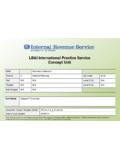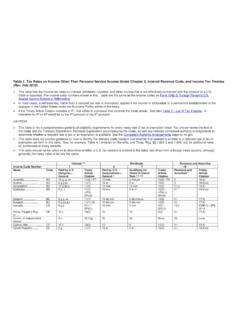Transcription of Economic Implications of the Regional Comprehensive ...
1 ASIAN DEVELOPMENT BANKASIAN DEVELOPMENT BANK6 ADB Avenue, Mandaluyong City1550 Metro Manila, Implications of the Regional Comprehensive Economic Partnership for Asia and the PacificThe Regional Comprehensive Economic Partnership (RCEP) presents strong potential to mold Regional trade and investment patterns well into the future and to influence the direction of global Economic cooperation at a challenging time. This paper evaluates the RCEP s impact on global and Regional incomes, trade, Economic structure, factor returns, and employment using a computable general equilibrium model. The results suggest that the RCEP agreement could generate sizable global income gains. Together with the CPTPP, RCEP will also strengthen the region s manufacturing supply chains, raising productivity and increasing wages and the Asian Development BankADB is committed to achieving a prosperous, inclusive, resilient, and sustainable Asia and the Pacific, while sustaining its efforts to eradicate extreme poverty.
2 Established in 1966, it is owned by 68 members 49 from the region. Its main instruments for helping its developing member countries are policy dialogue, loans, equity investments, guarantees, grants, and technical Implications OF THE Regional Comprehensive Economic PARTNERSHIP FOR ASIA AND THE PACIFICCyn-Young Park, Peter A. Petri, and Michael G. PlummerADB ECONOMICSWORKING PAPER SERIESNO. 639 October 2021 ASIAN DEVELOPMENT BANKADB Economics Working Paper SeriesEconomic Implications of the Regional Comprehensive Economic Partnership for Asia and the PacificCyn-Young Park, Peter A. Petri, and Michael G. PlummerNo. 639 | October 2021 Cyn-Young Park is a director at the Economic Research and Regional Cooperation Department (ERCD), Asian Development Bank (ADB).
3 Peter A. Petri is a professor at Brandeis International Business School, and a non-resident senior fellow at the Brookings Institution. Michael G. Plummer is the director of the School of Advanced International Studies (SAIS) Europe, Johns Hopkins University; and a non-resident senior fellow at the East-West Center. In addition to participants at the ADB-ERCD Research Seminar on 3 June 2021, the authors thank Sang-Hyop Lee (University of Hawaii), Andrew Mason (East-West Center), Marinos Tsigas (United States International Trade Commission), Anna Robeniol (Association of Southeast Asian Nations Secretariat), Carmen Estrades (Universidad de la Rep blica, Uruguay), and Pramila Crivelli (ADB) for offering insightful comments and sharing their valuable data; and Mara Tayag for data support.
4 Creative Commons Attribution IGO license (CC BY IGO) 2021 Asian Development Bank6 ADB Avenue, Mandaluyong City, 1550 Metro Manila, PhilippinesTel +63 2 8632 4444; Fax +63 2 8636 rights reserved. Published in 2313-6537 (print), 2313-6545 (electronic) Publication Stock No. WPS210371-2 DOI: The views expressed in this publication are those of the authors and do not necessarily reflect the views and policies of the Asian Development Bank (ADB) or its Board of Governors or the governments they represent. ADB does not guarantee the accuracy of the data included in this publication and accepts no responsibility for any consequence of their use. The mention of specific companies or products of manufacturers does not imply that they are endorsed or recommended by ADB in preference to others of a similar nature that are not making any designation of or reference to a particular territory or geographic area, or by using the term country in this document, ADB does not intend to make any judgments as to the legal or other status of any territory or work is available under the Creative Commons Attribution IGO license (CC BY IGO) By using the content of this publication, you agree to be bound by the terms of this license.
5 For attribution, translations, adaptations, and permissions, please read the provisions and terms of use at # CC license does not apply to non-ADB copyright materials in this publication. If the material is attributed to another source, please contact the copyright owner or publisher of that source for permission to reproduce it. ADB cannot be held liable for any claims that arise as a result of your use of the contact if you have questions or comments with respect to content, or if you wish to obtain copyright permission for your intended use that does not fall within these terms, or for permission to use the ADB to ADB publications may be found at : In this publication, $ refers to United States dollars.
6 ADB recognizes China as the People s Republic of ADB Economics Working Paper Series presents data, information, and/or findings from ongoing research and studies to encourage exchange of ideas and to elicit comment and feedback about development issues in Asia and the Pacific. Since papers in this series are intended for quick and easy dissemination, the content may or may not be fully edited and may later be modified for final publication. CONTENTS TABLES AND FIGURES iv ABSTRACT v I. INTRODUCTION 1 II. THE Regional Comprehensive Economic PARTNERSHIP AGREEMENT 2 III. MODELING THE EFFECTS OF THE Regional Comprehensive 6 Economic PARTNERSHIP AGREEMENT IV.
7 ESTIMATES OF THE EFFECTS OF THE Regional Comprehensive 8 Economic PARTNERSHIP AGREEMENTAND other POLICIES A. Aggregate income and Trade Effects of Major Policy Changes 9 B. Labor Market Implications of Trade Policy Developments 12 C. Sources of income and Trade Gains 14 D. How Policy Changes Will Affect Trade Patterns 17 E. Sectoral Effects of Trade Policies 19 V. CONCLUSION 21 APPENDIX 23 REFERENCES 26 TABLES AND FIGURES TABLES 1 Provisions of the Comprehensive and Progressive Agreement on Trans-Pacific 3 Partnership and the Regional Comprehensive Economic Partnership Agreement 2 Specifications for Simulating Asia and the Pacific Policies 7 3 income Effects of Asia and the Pacific Policies 9 4 Export Effects of Asia and the Pacific Policies 10 5 Barriers Applied to the Regional Comprehensive Economic Partnership 15 Exports in Intra-RCEP Trade, by Exporter 6 Barriers Applied to the Regional Comprehensive Economic Partnership 19 Exports in Intra-RCEP Trade.
8 By Sector A1 Labor Supply Elasticities 25 FIGURES 1 Real Returns to Labor under Asia and the Pacific Policies 13 2 Employment Effects under Asia and the Pacific Policies 14 3 Composition of Global income Effects of the Regional Comprehensive 16 Economic Partnership, by Liberalization Instrument 4 Composition of the Global Trade Effects of the Regional Comprehensive 17 Economic Partnership, by Liberalization Instrument 5 Export Changes under Asia and the Pacific Policies 18 6 Sectoral and Regional Export Effects of Asia and the Pacific Policies 20 ABSTRACT The Regional Comprehensive Economic Partnership (RCEP) presents strong potential to mold Regional trade and investment patterns well into the future and to influence the direction of global Economic cooperation at a challenging time.
9 This paper evaluates the RCEP and estimates its potential effects on income , trade, Economic structure, factor returns, and employment using a computable general equilibrium model. The results suggest that the RCEP agreement could generate global income gains that will be almost twice as large as those of the Comprehensive and Progressive Agreement on Trans-Pacific Partnership (CPTPP). RCEP effects on the region s trade will also significantly deepen Regional production networks and raise productivity. At the sectoral level, exports and imports of nondurable and durable manufactures will experience the most growth. The CPTPP and RCEP will especially strengthen the region s manufacturing supply chains, increasing wages and employment.
10 Keywords: computable general equilibrium, Comprehensive and Progressive Agreement on Trans-Pacific Partnership, free trade agreement, Regional Comprehensive Economic Partnership, rules of origin, supply chains JEL codes: F13, F15, F17 I. INTRODUCTION The 15 negotiating parties of the Regional Comprehensive Economic Partnership (RCEP) made history on 15 November 2020 by signing the largest free-trade agreement (FTA) ever in size ($26 trillion in gross domestic product) and population ( billion). It is the second megaregional trade agreement in Asia and the Pacific, following the Comprehensive and Progressive Agreement on Trans-Pacific Partnership (CPTPP) that became effective in December 2018.













